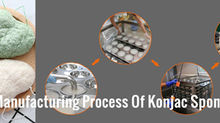What is the manufacturing process of the konjac sponge?
Updated: Mar 20, 2024
What's KONJAC?
First, let's find out the raw material for making konjac sponge.
Konjac, also known as konjak ;konnjaku, Amorphophallus konjac is a perennial herb, called in ancient China: Devil's tongue.
Konjac has many functions, such as lowering blood glucose, lowering blood fat, lowering blood pressure, losing weight, laxative, appetiser, etc.
The whole plant of konjac is poisonous and cannot be eaten raw.

The morphological characteristics of konjac
Konjac subterranean tuber for oblate spherical, large, petiole thick, cylindrical, light green, dark purple spots, palm-shaped compound leaves, inside is white.
Plant height about 40~70 cm, underground bulbs, a plant only long leaves, pinnate compound leaves, petiole thick long like the stem, flowering purple-red, have a different odour, underground tubers around.

The history of konjac
China as early as 2000 years ago began to cultivate konjac; culinary history is quite long. It later konjac from China to Japan, deeply loved by the Japanese as a medicinal food. Almost every meal must eat it, in modern Japan it is also the most popular folk food, and some parts of Japan also clearly stipulated that primary and secondary school students must have konjac food in the meal.

The nutritional value of konjac
Konjac contains 16 kinds of amino acids, 10 types of mineral trace elements and luxurious food fibre, which has unique effects on preventing diabetes and hypertension.
Konjac low heat, low fat, low sugar, to the prevention and treatment of colon cancer, breast cancer, obesity can be said to be a superior not only a full mouth, and cure health food, but also can prevent and cure a variety of common chronic diseases of the digestive system.
Thus it can be seen that konjac is a kind of "God-given medicine"; there is a great benefit to eat.

Konjac planting in China
Where is the origin of konjac?
Mainly distributed in southeast Asia, Africa, and other places; China, Japan, Myanmar, Vietnam, Indonesia, and other countries.
Konjac producing areas in China are mainly distributed in Yunnan, Guizhou, Sichuan, southern, and Western Hubei, with the most abundant konjac resources in the mountainous regions around the Sichuan basin.
Konjac producing areas in Sichuan are mainly distributed in the DaBaShan mountains in the east of Sichuan, and the Jinsha river valley in the southwest is the essential white konjac producing area in China.
Konjac powder is obtained by peeling, slicing, drying, crushing and sifting tubers after drying.
The raw material of PUSPONGE KONJAC is extracted from wild plant konjac 600-1400m high in a mountainous area and refined by a special process. Unique natural plant fibre cleans the skin from deep and keeps the skin away from dust. And the erosion of various environmental pollution in modern society ensures you have healthy skin and beautiful appearance.

1. Add konjac powder and calcium hydroxide to cold water, then mix well.
Mix the ingredients thoroughly to achieve even mixing. If the powder or air is mixed together, the product is not right, so this process is essential to get the highest quality, must be careful.

2. Quickly pour the mixture into the mould.
This process is done carefully step by step to ensure that no air or bubbles enter. The liquid form of konjac will immediately harden, so if poured too slowly, it will not form properly.
In the event of such a glitch, the defective product would be added to the traditional Chinese delicacy of konjac tofu for everyone to eat (Haha.)

3. The moulded konjac is arranged in a row on a large shelf and then solidified.
At this point, the sponge is still jelly-like. By leaving them on the shelf, they slowly solidify into a firm texture. Allow the solidification process to proceed slowly so that the konjac is creamy and soft. This step is vital for implementing spongy surfaces.

4. Simmer the konjak on a rack for 5 hours until completely stiff.
Carry on the "Alkali Heat Solidification" process, make konjak edible. The heat spreads to the inside of the konjac, and the process continues until it is completely hardened.

5. Shaped konjac sponge
The konjac is finished, but it's still hot, so place it in a pot of water and slowly cool down to the core. Also, freshly made konjac doesn't taste good in the heat.

6.Konjac Drying process.
Air drying process: a low cost and old drying process, but the shape is much smaller in the dry state, and the surface is atrophic and uneven.
Freeze drying process: a new drying process, relatively high cost, but in the dry state shape is more regular and beautiful, the first time to use the water absorption rate is faster, more conducive to the customer's primary user experience.
Freeze-drying products are our main advantages, with better quality and better prices than other products.
The mechanisms used in this process are as follows:
By freezing the product, the water is separated from the solid substance (konjac fibre), and then the water is dispersed into ice.
By defrosting the product, the cold parts become porous.
Only the original flexibility of konjac fibre, forming a sponge.
The product is then repeatedly frozen and thawed in a special freezer until it is uniformly frozen to the core.

7.Packaging Konjak sponge
The checklist confirms the following points:
Any damage or foreign body in the product?
Any deterioration or colour change?
Measure size and weight
Check PH value, TU value, etc
Enter the packaging stage.
Konjac sponge for Baby
































Commenti